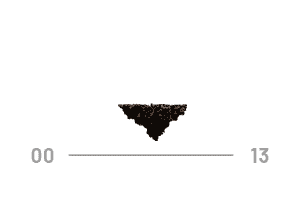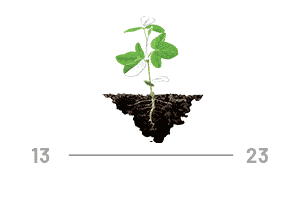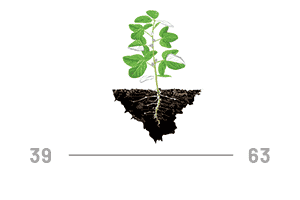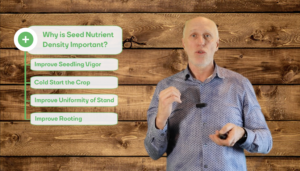
Soybean
growth stages and how to use plant nutrition and biostimulants to maximize
the genetic potential of your crop.
What are the nutritional requirements of a soybean crop?
Watch the video to learn about what nutrients are required by a soybean crop and the best times to apply them.
Essential nutrition for soybean crops
Essential nutrition for soybeans can be divided into five key stages. Preventing a nutrient deficiency at each of these stages is crucial for preserving the genetic potential of the crop to maximize yield potential. Use the tabs below to learn about the key nutrients required for each stage:
(Fungicide Timing)

Seeds are naturally nutritionally imbalanced – adding a seed nutrient dressing with the following nutrients can help the seedling get off to a strong start.
- Add an Inoculant to the seed to drive Nitrogen fixation.
- Soybean seeds are naturally nutritionally imbalanced – adding a seed nutrient dressing can help the seedling get off to a strong start. However, caution must be taken to ensure nutrient like Zinc are not added as it can harm the seed applied inoculant.
- Nutrients such as molybdenum formulated with biostimulants (Transit S and Cellburst) can help drive rooting and enhance early seedling vigour, without having negative effects on the inoculant.
- The other key goal with adding biostimulants to the seed is to address and help overcome early season stresses, such as cold soils.

To address the needs of the seedlings (and limitations within the seed) it is vital to ensure the soil has the key nutrients properly placed (either seed placed or banded close to the seed) to drive rooting, photosynthesis and early season vigor
- Zinc – auxin production to drive rooting
- Manganese – photosynthesis (responsible for splitting the H2O molecule)
- Boron – cell membrane integrity for strong, healthy roots
- Biostimulants (Synergro M2) – drive rooting and improved nutrient use efficiency
- Phosphorus* – energy production and photosynthesis
- Seed placed Phosphorus can injure a soybean crop and should NOT be applied in the seed row. If you are applying phosphorus, apply as a side or deep band.

During the vegetative growth stage, the crop is ramping up nutrient demand and energy production while still having a limited root system to acquire nutrients from the soil. The 3-6 leaf stage (V3-V6) is the ideal timing to combine these critical nutrients with a herbicide application to meet the increased nutritional demand of the crop and optimizing each pass across the field:
- Phosphorus – energy production and photosynthesis
- Potassium & Magnesium – critical for carbohydrate movement
- Zinc – root and shoot differentiation and moisture acquisition
- Manganese – optimize enzyme production and carbohydrate metabolism
- Boron – membrane integrity for strong, healthy roots
- Molybdenum – essential for optimizing nitrogen fixation by rhizobium
- Biostimulants (Transit-S and Cellburst) – abiotic stress management, root growth, & improving nutrient uptake and efficiency
(Fungicide Timing)

As the crop moves to the reproductive stage, there are key nutrients essential for pollination and fertilization. Ensuring these nutrients are present in adequate amounts prior to pollination is key:
- Zinc – auxin production for pollen tube elongation
- Boron – pollen tube growth and pollination
- Calcium – cell wall strength in the stigma
- Potassium – critical for carbohydrate movement
- Molybdenum – critical to convert nitrate-N into amino acids and proteins
- Biostimulant (Cellburst) – pollen tube growth and elongation
During later season ripening, this is the stage where nutrition can impact the quality of the cereal crop. Applying these nutrients later in the season can have a positive impact on ensuring yield and seed quality:
- Nitrogen – required when yield potential is greater than what rhizobium alone can supply to the plant.
Ho much nutrition does your crop need?
Use our crop uptake and removal calculator to determine how much of each nutrient is required for your targeted yield.
System of Chemtrition

Developed in the lab and perfected in the field, the Chemtrition three-stage system works in tandem with your seed treatment, herbicide, and fungicide plan to deliver essential nutrients throughout the plant’s life cycle. Release the genetic potential of your crop through a proactive, balanced nutrient plan and get the most out of every acre.
Chemtrition = AgChem + Nutrition
PreCede
+ Seed Protectant
Rate: 1.0L/MT Timing: Seed

- Drive root development, nodulation and maximize N fixation with the addition of key nutrients and biostimulants.
- Rhizobium friendly formulation.
- Low dose rate ensures flowability of seed when combined with seed protection product.
ReLeaf
+ Herbicide
Rate: 1.0L/ac Timing: Foliar

- Maximizes photosynthetic activity and eliminates flashing that occurs during stress periods with proper forms and levels of manganese and zinc.
- Maximize rooting and phosphorus uptake while being synergistic with crop protection products.
- Improve herbicide compatibility with sulphur to condition water.
- Drive nutrient uptake and efficiency by the plant with key biostimulants
42PHI
+ Fungicide
Rate: 0.5-1.0L/MT Timing: Foliar

- Increase nutrient uptake and plant health with the synergy of the fungicide with the optimum load of phosphorus.
- Aids water management and ethylene inhibition with potassium.
- Improves pollen viability and pollination with additional zinc and boron.
Proven Agronomic Performance
Field trials conducted in North America proved the synergistic effects of the System of Chemtrition in soybeans, showing an average yield increase of 23%.

Achieving your genetic potential with soybean
ATP’s soybean nutrition program helps you achieve the genetic potential of your crop – maximizing yield and quality. ATP’s comprehensive product portfolio provides you with a wide range of options to meet all your pulse nutritional requirements.
BBCH
TIMING

Seed Treatment

Soil

Herbicide

Fungicide
PreCede Rhizo
Transit-S + Cellburst + TE
Micro-Che
ReLeaf Soybean
2-23-2-0.6S-3Mn-1Zn + Transit-S + Cellburst + TE
Ruffin-Tuff Crop Mix ll
6Zn-3Mn-1.5Cu-1.5B-8S
Kinetic Boron
10.0B + Transit-S + Cellburst + TE
NRG KB
2-0-15-1.5B + Cellburst
42PHI Rhizo
0-36-8-5Zn-3Mn
42PHI K+
0-21-14-0.3Zn + Cellburst
Related Articles

Cracking the Code on Seed Nutrient Density
Today, we’re diving headfirst into a topic that’s as vital to our crops as sunshine and rain: nutrient seed density. Let’s kick things off with

Lazy roots? Four ways to ensure your crop has access to moisture later in season.
Lazy Roots? For the most part, the Northern US has received adequate moisture and crops are off to a great start! However, with adequate moisture,

Are your crops stressed?
Chances are your crops have been through some stressful conditions this spring – lack of moisture, excess moisture, cold temperatures, hot temperatures – it’s been


